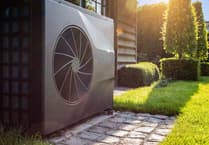Every month retired building air tightness technician Trevor Clark gives his advice on heating your home effectively.
This time, he offers up tips on cutting your energy costs with DIY insulation.
Firstly, try to keep all the service pipes and ducts inside the conditioned space, even if they are insulated themselves.
This is because when installed and insulated outside of the conditioned space the temperature is lower which increases energy transfer so thicker insulation is required.
Within ducts condensation will occur and the condensate water will appear when and where you least expect it to.
Duct insulation
Insulate ducts with insulation that is waterproof, as wet fibre insulation won’t perform and condensation will drip creating conditions where repairs will be expensive.
Ducts carrying air will suffer from condensation somewhere within the duct run, so it should have a slight ‘fall’ to allow the water to run out of the building.
Running ducts within the conditioned space reduces this risk, however eventually the duct must exit the building somewhere and at this point the run should allow the water to escape to the outside.
This applies to both fresh air inlet and exhaust ducts.
Condensation appears on the outside of fresh air inlet ducts during winter, while warm exhaust air leaving will condense water on the inside of the duct.
Pipe insulation
Pipes required insulation as they are the delivery roadway for the energy.
The energy is intended to get to the under floor pipes or radiators (heat emitters) around the building that heat the rooms. Energy lost along the length of a pipe can be considerable.
The best and easiest time to insulate pipes is when they are being installed.
You can slide the full length of insulation along the pipe and then use larger clips to hold the pipe in place. This means you just need to concentrate on the joint between each length. Glueing with an impact glue is best.
Use larger clips after insulating to hold pipes in place.
Your last option is to insulate the pipe between clips as above and then use a larger diameter pipe insulation to fit over each clip and glue these to the pipe insulation.
The aim is to cover and close all gaps to allow the energy to reach the ‘intended’ delivery point (emitter etc.)
Cold water tanks
If your cold water tank is in the attic, it will need insulating around the sides and over the top to the same thickness as the attic. Do not insulate under the tank, as you need some heat to be maintained so the water in the tanks does not freeze!
Should your cold water tank be inside the conditioned space, such as in a cupboard, then there should be no need to insulate it unless the tank causes condensation on the outside due to the cold water stored inside.
Domestic hot water cylinders
If you have a domestic hot water cylinder within the conditioned space, it’s a good idea to improve the thickness of the existing insulation (if any) and to make sure there are no bare pipes coming from the tank.
Most important is the top draw off pipe which should have an extra thick wrap of insulation as this first 1.5 metres of bare pipe can lose as much energy as the tank itself does.




